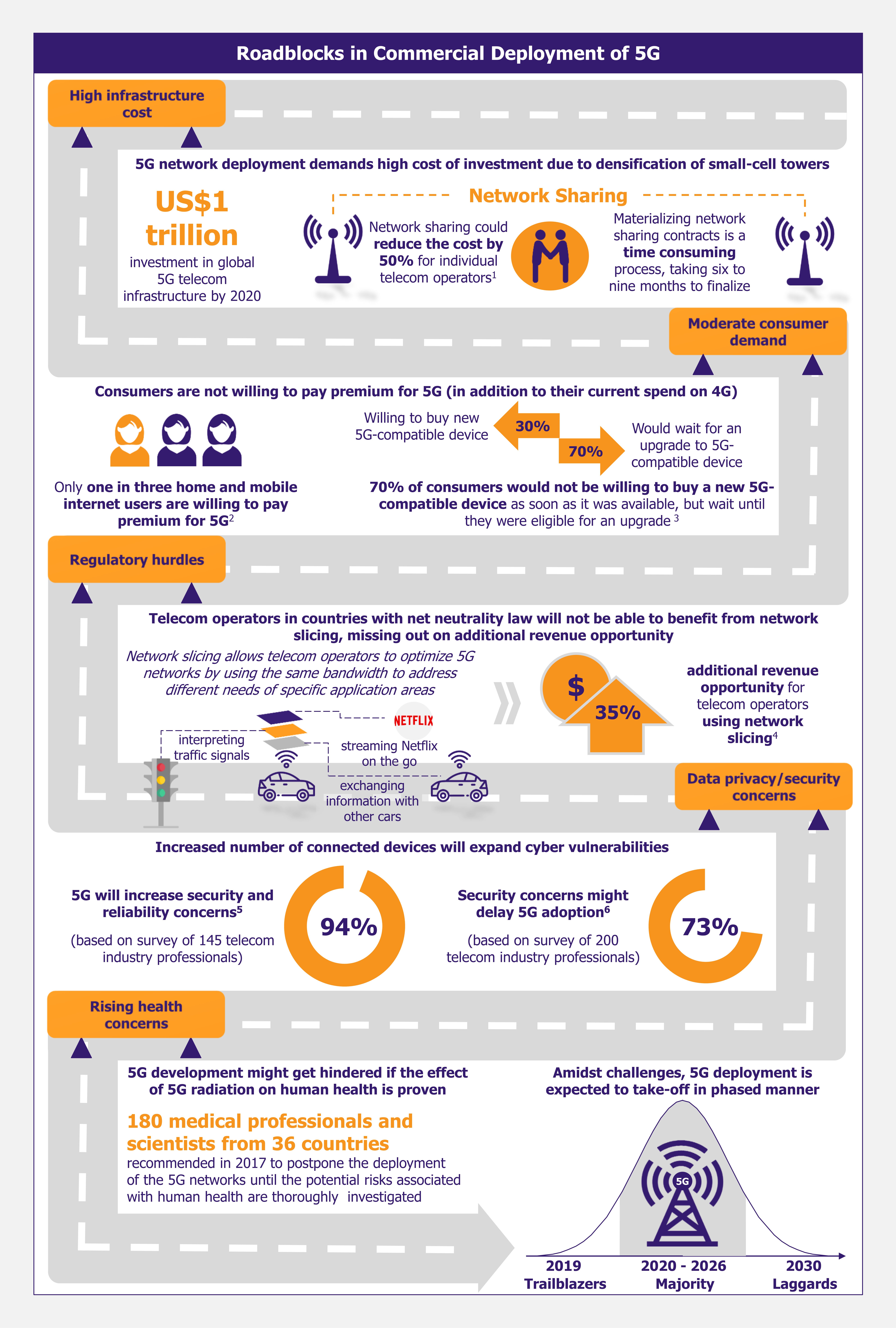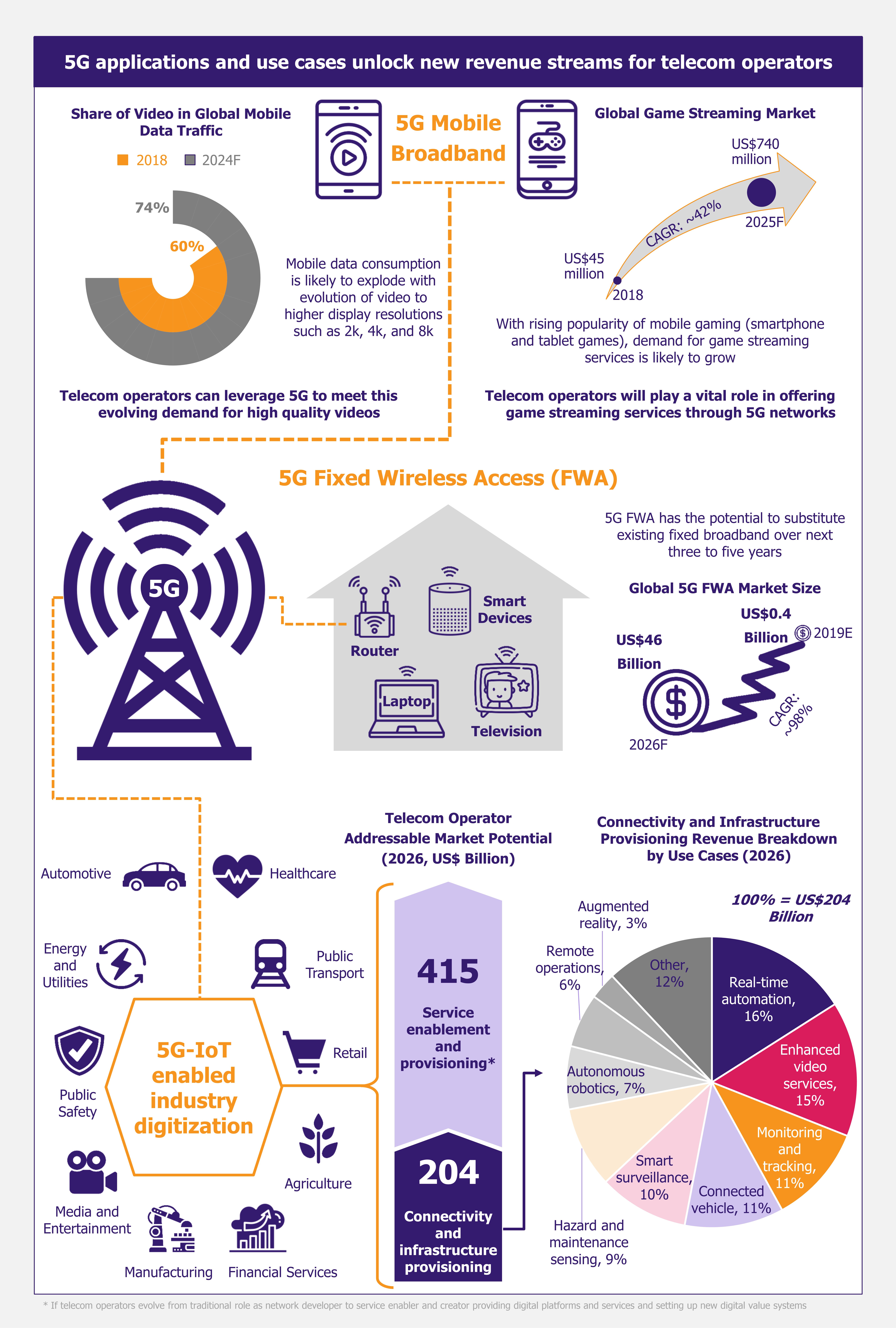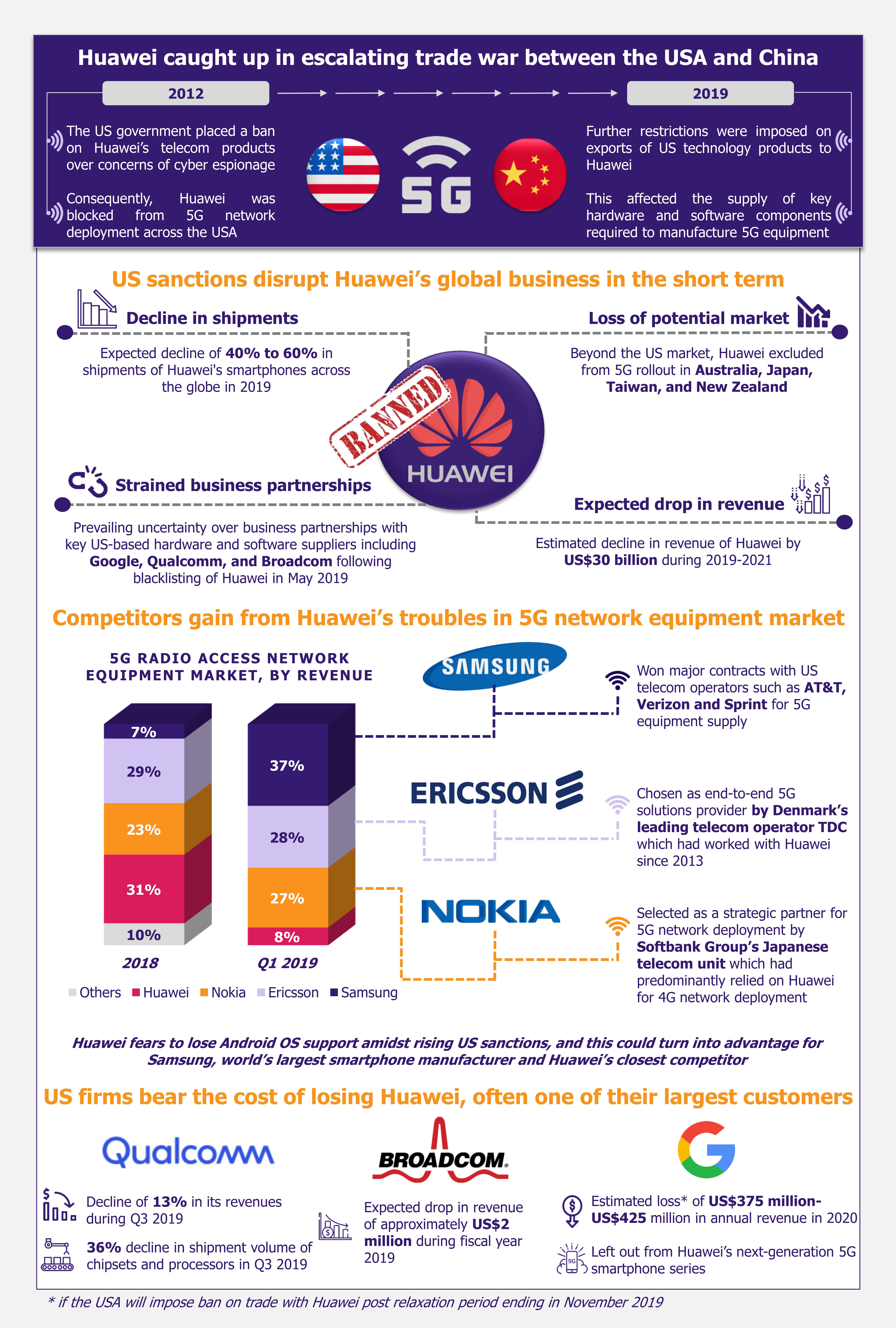5G technology started to become a buzzword around 2017, when it was still in a nascent stage of development, to say the least. Over the past two years, 5G has evolved from pilot testing phase to small-scale implementation. However, 5G full-scale deployment is yet to be seen and there are still many challenges to overcome. 5G is here, but it is still a long way before it becomes mainstream.
Developing 5G infrastructure is a costly affair
5G uses high frequencies and short wavelength to deliver faster speed and lower latency. Short wavelength requires shorter distance between the tower and the device, since the signal cannot penetrate buildings, trees, or other such obstacles. Therefore, telecom operators need to build 5G small-cell towers very close to the end-users, which is time consuming and expensive.
The high cost of investment is seen as a major pain point by majority of the telecom operators. A report released by a UK-based capital finance firm Greensill in February 2019 indicated that the investment in global 5G telecom infrastructure will reach US$1 trillion by 2020.
Network sharing is increasingly seen as a rational approach to reduce the individual cost of investment. In February 2018, McKinsey estimated that if three players share the 5G network, the individual costs can be reduced by 50%. However, setting up a collaboration with other telecom operators to share networks is a complex and time-consuming process. On an average, it takes about six to nine months to finalize a network sharing agreement. Each telecom operator will need to ink many such network sharing contracts to achieve wide-spread coverage of their services.
Despite the hype, demand for 5G is currently rather moderate
Despite all the promises of high-speed and uninterrupted internet connectivity, 5G is not seen as an immediate necessity. This is because the existing technology, 4G LTE, is able to fulfill most of the current consumer needs. The average 4G LTE data speed globally is estimated at around 17Mbps. Thus, 4G LTE provides sufficient speed for some of the most common mobile applications such as music streaming (~1Mbps), 1080p HD video (~5Mbps), and even online games such as Fortnite (~3Mbps).
As per a study conducted by PWC in September 2018, only about a third of 1,000 home and mobile internet users surveyed in the USA were willing to pay a premium for 5G, provided 5G delivers speed and low latency as claimed by the telecom operators. Moreover, survey finds that, for 5G internet service, home internet users were willing to pay a marginal amount of US$5.06 on average as monthly premium in addition to their current spending on 4G. Mobile internet users were willing to spend even less, a monthly premium of US$4.40 on average. To compare, a US-based telecom operator Verizon offers unlimited 4G data and calls for US$65 per month.
Moreover, most of the 4G devices do not support 5G networks, thus require consumers to spend additionally on 5G-compatible devices. This additional cost factor is also expected to act as a deterrent for mass adoption of 5G in the near term. Another survey (conducted by PWC in May 2019) of 800 internet users in the USA found that if a new device was required to access 5G, 70% of the respondents would not be willing to buy a new 5G-compatible device as soon as it was available, rather wait until they were eligible for an upgrade.
Thus, the marketing hype created around 5G have got consumers intrigued about the technology, however, they are not open to spending generously on the 5G experience.
Net neutrality law dampens motivation to invest in 5G
5G would enable network slicing allowing telecom operators to dedicate a portion or slice of their 5G network with certain functionality such as connectivity, speed, or capacity. In other words, network slicing creates various networks that share the same physical infrastructure without impacting other network functionalities.
For instance, in automated cars, one slice could be used for watching Netflix and other could be used for exchanging reliable information with other cars to avoid any road accidents. Network slicing is a real opportunity for telecom operators to optimize their 5G networks to address different needs of specific application areas.
Furthermore, differentiated services provided with each network slice using the same physical infrastructure are likely to increase revenue potential for telecom operators. A research study conducted by Ericsson in 2018 concluded that telecom operators can generate up to 35% more in revenue using network slicing (the study assumed a 5G mobile broadband had 25 million subscribers with 40 unique services launched per year over the period of five years).
However, the net neutrality regulation adopted by many countries across the world does not permit the use of network slicing technique. Net neutrality laws are in effect in the EU since 2016. In North America, Canada has net neutrality regulation in place, but in the USA the status of the law is under review. Most countries in South America have national laws to protect net neutrality. In Asia, Japan, South Korea, and India are among the few countries with net neutrality regulation. Africa, in particular, is lagging behind other regions in developing concrete framework to protect net neutrality.
The net neutrality law dictates telecom operators to treat all internet communications equally and prohibits them to charge differently for different internet services. Net neutrality law does not allow the telecom operators to use network slicing technique to create distinguished service offerings by blocking any part of bandwidth for a particular application or user group.
Telecom operators argue that this impacts the roll out of mission-critical and emergency services such as remote surgery which needs to be given priority over other applications. With net neutrality in the picture, telecom operators would not be able to benefit from the key feature of 5G technology, network slicing. This may hinder the overall 5G development.
As telecom operators voice their concerns, regulators across the world are reviewing net neutrality laws. EU opened consultations with industry stakeholders as telecom operators in the region propose 5G to be classified as a specialized service which is exempted from net neutrality laws.
In the USA, the status of net neutrality law (introduced in 2015) remains unclear. In June 2018, the Federal Communications Commission (FCC) repealed net neutrality regulation, however the decision was opposed by 22 states. State legislators have challenged the FCC decision in the US Court of Appeals and proposed to authorize the state-level legislations to re-instate net neutrality laws. In the 2019 legislative session, 29 states introduced laws to protect net neutrality at state level.
5G to multiply data privacy and security risks
5G does not drastically change the risk factors similar to those in the existing communication technologies (i.e. 2G, 3G, and 4G), however, it is going to dramatically increase the potential points of cyberattacks. This is due to the fact that the advent of 5G is expected to result in exponential increase in the number of connected devices and associated network data traffic, which will significantly expand the number and scale of cyber vulnerabilities.
A study (released in May 2019 by Business Performance Innovation (BPI) Network, a professional networking organization) based on a global survey of 145 telecom industry professionals, indicated that 94% of respondents believed that 5G will increase security and reliability concerns.
Another survey conducted in June 2019 by Cradlepoint, a cloud-based networking solutions provider, indicated that 73% of the 200 respondents (working with telecom operators) acknowledged that security concerns might delay the 5G adoption.
Explore our other Perspectives on 5G
Industry is turning to standardization and regulatory bodies for guidance on minimizing security threats associated with 5G. But existing standards do not fully address the data privacy and security concerns.
For instance, the existing 5G standard employs Authentication and Key Agreement (AKA) protocol which is a mutually authenticating system between the user device and 5G network. However, in late 2018, it was discovered that the 5G AKA has at least two vulnerabilities that could compromise users’ data privacy and security. Firstly, it allows interception of the communication between two users, enabling cyber spies to steal personal information or corrupt data. Further, the vulnerability in 5G AKA protocol could allow cyber criminals to bill the phone call or other charges to legitimate users.
5G standards are still under development and will take some time to come into effect. Since 5G is a new technology, many data privacy and security threats still remain unidentified. In anticipation of potential security flaws, telecom operators may adopt a wait-and-see approach before moving to wide-scale commercial deployment of 5G.
5G draws criticism over possible health concerns
It is believed that prolonged exposure to electromagnetic radiation from 5G networks can be harmful to human health. In 2011, cellular radiation was classified as a possible carcinogen by World Health Organization. 5G radiation is also claimed to be linked to premature aging, disruption of cell metabolism, as well as neurological disorders. However, there is little evidence to understand the actual extent of the harm caused, and therefore many countries are not giving this issue due attention.
However, rising health concerns are not going unnoticed. In September 2017, 180 medical professionals and scientists from 36 countries recommended the European Commission to postpone the deployment of the 5G network until the potential risks for human health and environment are thoroughly investigated and proven. In response, the European Commission indicated that the member states are responsible for protecting their citizens from harmful effect of electromagnetic radiation and they can introduce choice of measures based on the demographics. This means that, in the future, if the presumed adverse effect of 5G radiation on human health is proven to be true, countries can impose protectionary measures which would limit the development of 5G.
Some countries have already taken a cautious approach to 5G deployment in view of potential health risks. An example of this could be Belgium stopping a 5G test in Brussels in April 2019 due to difficulty in measuring electromagnetic radiation emissions. Around the same time, Swiss government also announced plans to introduce radiation monitoring systems to continually assess health risks posed by 5G radiation. Earlier in September 2018, Mill Valley, a city in San Francisco, USA, banned deployment of small-cell 5G towers in the city’s residential areas.
Thus, growing concerns over impact of 5G on human health is expected to further delay the 5G development and adoption.
1) According to McKinsey estimates (February 2018) based on the assumption that three players share the 5G network
2) Based on survey of 1,000 home and mobile internet users in the USA conducted in September 2018 by PWC
3) Based on survey of 800 home and mobile internet users in the USA conducted in May 2019 by PWC
4) As per Ericsson 2018 study, assuming a 5G mobile broadband having 25 million subscribers with 40 unique services launched per year over the period of five years
5) According to May 2019 study by Business Performance Innovation (BPI) Network
6) Based on a survey conducted by Cradlepoint in June 2019
EOS Perspective
While the 5G technology era has arrived, wide-scale commercial deployment is moving slowly amidst challenges it is facing. Cradlepoint study indicated that 46% of the 200 telecom industry professionals surveyed in June 2019 had made little or no preparations for 5G deployment.
4G (introduced in 2009) accounted for 43% of the total mobile subscriptions globally by the end of 2018. Even after a decade, there are still many regions where people do not have access to 4G.
Transitioning from existing communication technologies to 5G is more complex, costly, and time-consuming. Hence, 5G is years away from full-scale commercial deployment. GSMA, an industry association with over 750 telecom operators as members, predicts that while 4G will continue to grow to reach 60% of the global mobile subscriptions in 2025, 5G will account for just 15% of the market by then.
5G has been in the news for some time now and it is marketed as the future of communication and internet technology. 5G has gone through many upgrades and is deemed ready for commercial deployment, at least on a small scale. Many leading telecom operators today are preparing for the rollout of 5G networks while uncovering new challenges in the process.
The road to 5G might be longer than expected, given the challenges on the way. TBR, a technology research firm, expects that only few trailblazers would have attempted to deploy 5G by the end of 2019. Majority of telecom operators will deploy 5G between 2020 and 2026. Laggards will follow them and continue with 5G deployment till 2030.







